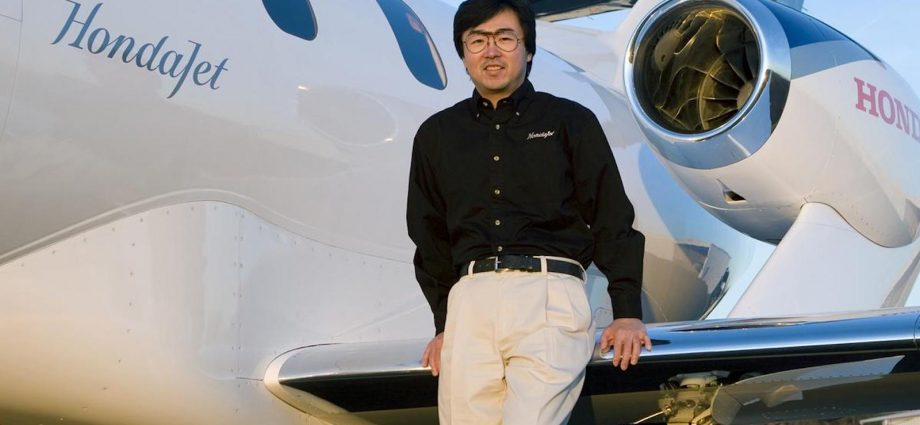Honda Aircraft Company has launched an upgraded version of its Elite model business jet, a move expected to keep it at the leading edge of the light jet market. Honda Aircraft’s headquarters and factory are located next to Piedmont Triad International Airport, near Greensboro, North Carolina.
The HondaJet Elite II was unveiled on October 17 at the 2022 National Business Aviation Convention and Exhibition in Orlando, Florida. Like its predecessor, the Elite S, it is the fastest, highest and farthest flying and most fuel-efficient aircraft in its class with a range of 1,547 nautical miles (2,865 kilometers), a maximum cruising altitude of 43,000 feet and a maximum cruising speed of 422 knots (782 kilometers/hour).
It also has the most cabin space, with a typical configuration of one crew + six passengers and an alternative configuration of one crew + seven passengers or two crew + six passengers.
The Elite II features HondaJet’s characteristic over-the-wing engine mount, a configuration that improves performance by reducing aerodynamic drag.
It is powered by a HF120 turbofan jet engine made by GE Honda Aero Engines, a joint venture headquartered in West Chester, Ohio, that was created in 2004 to design, manufacture, sell and service engines for business aviation.
The Garmin G3000 avionics system features a touchscreen flight deck and is scheduled to include an emergency autoland system to autonomously control and land the aircraft without human intervention starting in the second half of 2023.
In 2021, HondaJet was the most delivered aircraft in its class for the fifth year in a row, according to data from the General Aviation Manufacturers Association. Honda Aircraft delivered 37 aircraft to customers last year, bringing total deliveries to 200 aircraft in late December.

In addition, the US Federal Aviation Administration (FAA) awarded Honda Aircraft Company its “Diamond level AMT employer award,” the highest level in the William (Bill) O’Brien Aviation Maintenance Technician Awards program. Also in 2021, Aviation International News awarded the Elite S a “Top Flight Award” for best new business jet.
The US is Honda Aircraft’s biggest market but the company’s sales and service network is global. HondaJet has received 14 type certifications around the world, including in the US (FAA), Europe (EASA), Mexico (AFAC), Brazil (ANAC), Argentina (ANAC), Panama (AAC), India (DGCA), Japan (JCAB), Canada (TCCA), China (CAAC), Turkey (DGCA), Pakistan (PCAA), Russia (FATA) and Thailand (CAAT).
Shoichiro Honda, Honda Motor’s founder, had always wanted to build airplanes. He and his wife had private pilot’s licenses and he continued hang-gliding and ballooning into his 70s.
A lifelong mechanic with no formal education, he was famous for his oil-stained hands, pink suits and his defiance of government bureaucrats who tried on more than one occasion to restrict his business.
Shoichiro Honda died in 1991 but his company retained his interest in aircraft. In 1997, Michimasa Fujino, an engineer in Honda Motor’s aviation research division, designed the company’s over-the-wing engine mount. In 2006, when Honda Aircraft Company was established, he became its first president.
[For those who are interested in such things, Germany’s VFW-Fokker 614, introduced in 1975 and retired in 2012, also had over-the-wing engines.]
The first flight of an FAA-conforming HondaJet was made in December 2010. In June 2014, the first HondaJet produced for shipment to a customer made its initial test flight. In December 2015, the HondaJet received type certification from the FAA. The press release quotes then-North Carolina governor Pat McCrory:
“As far back as the Wright Brothers’ first flight at Kitty Hawk, our role in aviation has always been significant. Now, when we look up in the sky, we will see jets made right here in North Carolina. Congratulations to Honda Aircraft Company on this enormous achievement.”
HondaJet’s shipments overtook those of Cessna in 2017. The HondaJet Elite was introduced in 2018, with its first aircraft delivered to Japan that year. Aircraft deliveries in China began in 2019.

Fujino retired on March 31, 2022 (the end of Honda’s last fiscal year). His successor is former Honda Motor vice president Hideto Yamasaki, whose task is to expand the business and put it on a sound financial footing.
With sales rising and more than two years of backlog, the main challenge seems to be keeping up with demand for HondaJets. In October, he told AINonline (Aviation International News), “Currently, we can’t build them fast enough.”
Yamasaki must also manage the introduction of the HondaJet 2600, a new and larger aircraft designed to carry 11 people (one crew + 10 passengers or two crew + nine passengers) on non-stop transcontinental flights of up to 2,625 nautical miles (4,862 km) at a maximum cruising speed of 450 knots (834 kilometers/hour).
The HondaJet 2600 will compete with established models from Gulfstream, Cessna, Bombardier and Embraer. That will be a test of Honda Aircraft’s technology, marketing and management, but judging from the record so far, the sky is the limit.
Follow this writer on Twitter: @ScottFo83517667

